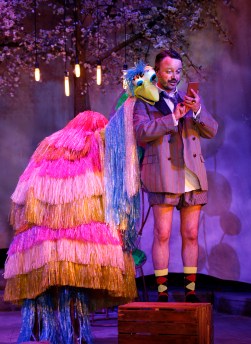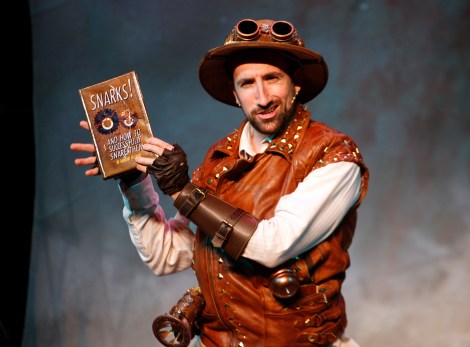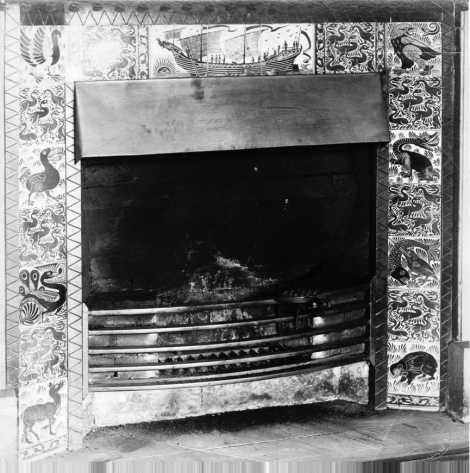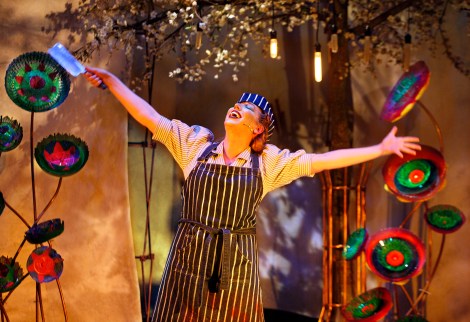In 1876 Lewis Carroll – the pen-name of Charles Lutwidge Dodgson, a mathematical lecturer at Christ Church, Oxford – who was also an avid reader and writer of poetry, published a fantastical epic tale recounting the adventures of an eccentric troupe of nine tradesmen explorers and a beaver.

Photo: Simon Annand
Although best known as the author of Alice’s Adventures in Wonderland (1865) and Through the Looking-Glass (1871), Carroll’s The Hunting of the Snark is the most inventive and intricate nonsense poem in the English language (with 141 stanzas in 8 cantos Carroll called fits). Despite being hailed a masterpiece however, it remains somewhat undiscovered – perhaps because of its length, mystery, and hidden meanings!
After a summer of West End performances, the new family musical adventure inspired by the poem is heading on tour. To celebrate, here are 20 Snarky factoids that will help you decipher the meaning of this enduring but cryptic work…
- Lewis Carroll dedicated the poem to Gertrude Chataway, one of his favourite child friends. The poem embodies her name as the first word of each stanza: Gert, Rude, Chat, Away.
- Carroll wrote Snark as escapist amusement while he was nursing his seriously ill godson and cousin Charlie Wilcox who eventually died from tuberculosis.
- Snark was written backwards. While Carroll was walking in the hills, the final line of the poem “For the Snark was a Boojum you see” arrived like a thunderbolt from his imagination and the rest of the preceding 141 stanzas would take him six months to complete.
- Carroll left the meaning of the Snark deliberately vague refusing to answer questions about its meaning until finally he admitted to friends that it was intended as an allegory on the search for happiness.
- Scholars have attributed a number of meanings to Snark, ranging from political subversion to existential angst; one theory holds that the expedition is a metaphor for a badly floated business venture.

Photo: Simon Annand
- The poem was published on April 1st 1876 (the date chosen with care being April Fools Day). The first print was 10,000 copies and the book has very rarely been out of print since. In Carroll’s lifetime alone, over 20,000 copies were sold.
- Unlike Carroll’s many other fantastical creatures, we never get to see the Snark and its appearance remains a mystery. Carroll refused to allow his lifelong friend the eminent illustrator Henry Holliday to include his drawing of the Snark (below) in the poem.

- Some Snarks are harmless and others are the fearsome Boojums which can “softly and suddenly vanish you away.”
- The Bellman is an expert on Snarks and outlines the five ways of distinguishing a Snark: they taste “meagre and hollow but crisp”; they get up late; they are bad at taking jokes; they have a fondness for bathing machines; they are ambitious; some have feathers and bite, and others have whiskers and scratch.
- There are several ways to hunt a Snark; you may seek it with thimbles, you may hunt it with forks and hope; you may threaten its life with a railway-share; or charm it with smiles and soap.
- Below is a picture of the famous fireplace in Lewis Carroll’s room at Christ Church Oxford where he taught mathematics. If you look closely, you can see the ship, the Beaver, the Jub Jub bird… and a rather frightening creature that might even be … the elusive mythical snark!

- Carroll was a great inventor of portmanteau words – a word blending the sounds and combining the meanings of two others, for example the Beaver’s galumphing is a combination of ‘gallop’ and ‘triumphing’.
- The Jub Jub bird appeared in Carroll’s Jabberwocky. Some think that the Jub Jub bird is a pun on the word jug-jug, an English word expressing one of the notes of a nightingale.
- Carroll’s thieving Bandersnatch previously appeared in Jabberwocky as well as Through The Looking Glass. His name is said to be a combination of the creature’s tendency to snatch along with Bandar (Hindustani for rhesus monkey.)
- Snark clubs dedicated to ‘the glorification of the Snark and its creator’ have flourished at both Oxford and Cambridge; the Cambridge group still meets in London. The band of declared Snarkists include W.H. Auden, Willa Cather, John Galsworthy, A.P. Herbert, Elspeth Huxley and C.S. Lewis.

Photo: Simon Annand
- The Snark has been read by Alec Guiness, Alan Bennett and Bori Karloff (who recorded the poem on to vinyl in 1959).
- Acclaimed American author Edith Wharton and family friend President Theodore Roosevelt were both great fans of Snark and would quote the poem to one another extensively during lunch.
- Many believe The Baker is Carroll’s self-deprecating self-portrait making fun of his own absent-mindedness. Like Carroll, The Baker is named after his uncle and is in his early 40’s. He has 42 boxes of luggage and Carroll was 42 when he wrote Snark.

Photo: Simon Annand
- During his lifetime, Carroll had been fascinated by absurd court cases and The Barrister’s Dream is said to be a satire of the Tichbourne case. When Sir Roger Charles Tichbourne was lost at sea, his mother refused to believe her son was dead and put an advertisement in the paper for news of him. Sure enough a butcher from Wagga Wagga in New South Wales Australia answered her ad and while he bore no resemblance to her son, more than 100 people swore that he was in fact Sir Roger.
- There is an unmistakable resemblance between Henry Holliday’s illustration of The Bellman and the Victorian poet Lord Alfred Tennyson whose poems Carroll had been parodying since 1856.
The Hunting of the Snark will tour from September 24th. For more information & to book tickets, visit www.snarkthemusical.com
